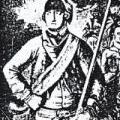 No account of the Eastern Townships would be complete without mentioning Rogers' Rangers and what has become one of the more infamous episodes in Townships lore. After the fall of Quebec in 1759, but before the war was completely over, British General Jeffery Amherst decided to punish the St. Francis Abenakis for their frequent raids and steadfast support for the French. Major Robert Rogers, an experienced colonial officer, was selected to lead an expedition of 200 men. The destination was the Abenakis village of Odanak, a mission settlement near the mouth of the St. Francis River.
No account of the Eastern Townships would be complete without mentioning Rogers' Rangers and what has become one of the more infamous episodes in Townships lore. After the fall of Quebec in 1759, but before the war was completely over, British General Jeffery Amherst decided to punish the St. Francis Abenakis for their frequent raids and steadfast support for the French. Major Robert Rogers, an experienced colonial officer, was selected to lead an expedition of 200 men. The destination was the Abenakis village of Odanak, a mission settlement near the mouth of the St. Francis River.
On September 13, 1759, the expedition headed north by boat from Amherst's headquarters on Lake Champlain. An accident en route (a powder barrel exploded in camp) necessitated the return to base of forty of Rogers' men. The remaining 160 paddled on to Missisquoi Bay, at the north end of the Lake. After concealing their boats, they continued on foot through the forest. They were pursued, however, by about 200 men, both French and Indigenous. Their boats had been discovered in their hiding place, and no doubt the explosion had alerted the French in the area.
With increasing alarm, the expedition (minus a few men who were sent back to report the situation) pushed on through a terrain of swamp and forest. Avoiding the easier route of the Yamaska River, as it would have been too obvious a choice (and was certainly guarded by the French anyway), Rogers reached Odanak twenty-two days after receiving his orders.
On October 4, the expedition attacked the quiet little village. They met with little in the way of resistance, however, since most of the men were away hunting. The villagers who remained were almost all slain. A few were taken prisoner. Odanak itself was burned, and the mission church looted. A few English captives were freed, and corn and other articles were seized. Rogers reported having killed at least 200 villagers, though he probably grossly exaggerated the numbers (the real figure may have been closer to thirty). Most of the dead were women and children.
Retreating by way of the St. Francis River, Rogers was pursued by a group of warriors who had returned to the village to discover the carnage. The Abenaki managed to kill a number of Rangers in what is now Kingsey Township. With many of his men wounded, exhausted, and starving, Rogers pushed on towards Big Forks (present-day Sherbrooke). There he sent a detachment to Little Forks (Lennoxville) to build a fire so that the pursuers would think that was where the men were camped. Back on high ground at Big Forks, they surprised the Abenakis approaching upriver in their canoes and shot at them as they passed the lookout.
Rogers and his men continued on to Little Forks, where they separated into smaller parties, agreeing to rendezvous later in New Hampshire. Smaller groups, it was felt, would be harder to track, and hunting for food would be easier. All along the way, however, the retreating parties were pursued by the Abenaki. Many of the soldiers were killed. Others were captured and taken back to Odanak, where they were tortured. After much hardship, and the loss of many men, Rogers and a much diminished group straggled back into camp on Lake Champlain.